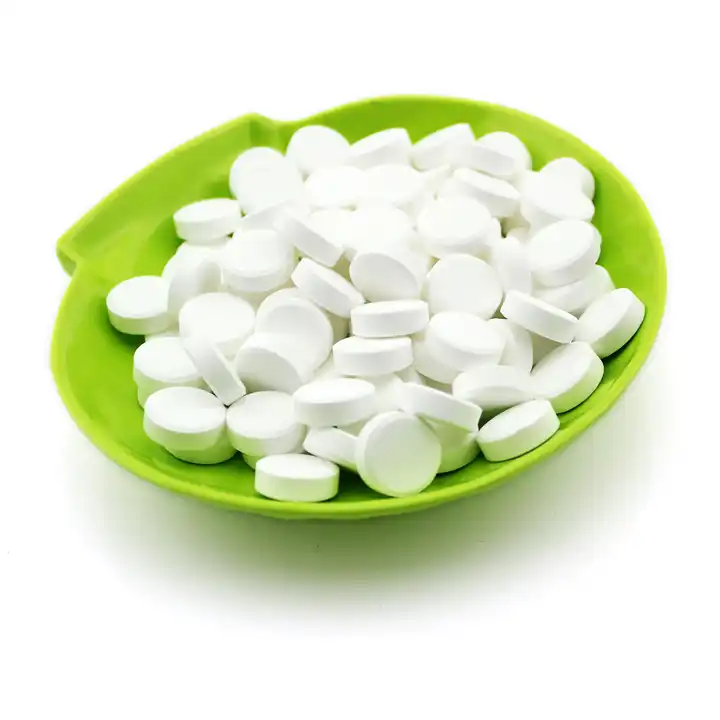Calcium hypochlorite, also referred to as high-efficiency bleaching powder, is predominantly composed of calcium hypochlorite. Depending on the manufacturing process, it may also contain calcium chloride, sodium chloride, or calcium hydroxide. Its active chlorine content is above 60%. The bleaching powder exhibits robust antimicrobial, disinfectant, purification, and bleaching properties, making it highly valuable in various industries like wool washing, textiles, carpets, and paper. Its primary mechanism involves the reaction of calcium hypochlorite with water and carbon dioxide to form hypochlorous acid, a strong oxidizing agent that eliminates stains. This article delves deep into its chemical properties, applications, and safety concerns.
Basic Information
Calcium hypochlorite is also known as high-efficiency bleaching powder or tricalcium hypochlorite dihydroxide. It manifests as a white powder or granular substance with a strong chlorine odor. Its chemical formula is 3Ca(ClO)2·2Ca(OH)2, with a molecular weight of 577.0.
Chemical Properties
As a white powder or granular chemical, calcium hypochlorite is a potent oxidizing agent that’s corrosive. It’s soluble in cold water but decomposes in hot water and ethanol. When heated, it decomposes rapidly and can potentially lead to explosions. In contact with acids, it liberates chlorine gas. Moreover, when it comes into contact with organic substances or oils, combustion may ensue. It might also break down under light exposure, producing oxygen and chlorine gases.
Manufacturing Process
The production process of calcium hypochlorite might introduce other components like calcium chloride or sodium chloride, as well as calcium hydroxide. However, its main active ingredient remains calcium hypochlorite with an effective chlorine content greater than 60%.
Application Areas
Bleaching and Textile Industry:
Calcium hypochlorite plays a pivotal role in the textile industry. It’s mainly employed for bleaching cotton fabrics, linen, and pulp. This is due to its capability to remove stubborn stains and improve the whiteness of fabrics. Moreover, as an oxidizing agent, it helps break down natural pigments without affecting the structural integrity of the textile fibers.
Disinfection and Purification:
A robust disinfectant, calcium hypochlorite is extensively utilized for purifying drinking water and swimming pool water. It efficiently eliminates pathogens, ensuring water safety for consumption and recreational purposes. Its high chlorine content effectively destroys bacteria, viruses, and other microorganisms.
Pharmaceuticals and Public Health:
In the pharmaceutical realm, calcium hypochlorite serves as a disinfectant. Given its antimicrobial properties, it’s applied in sanitizing hotel surroundings, hospitals, and other public places, ensuring a hygienic environment and mitigating the risk of disease spread.
Other Applications:
Apart from the aforementioned uses, calcium hypochlorite is also engaged in the production of chemical warfare agents, radioactive disinfectants, and in the chlorination process of rubber. Its robust oxidizing potential finds utility in multiple niche areas, from scientific research to industrial applications.
Usage Methods and Precautions
When working with calcium hypochlorite, certain precautions are crucial:
- It can be mixed with water to form a high-concentration bleaching solution.
- Store in a well-ventilated area, away from heat sources and direct sunlight.
- Avoid contact with organic materials, oils, or acidic substances.
- In case of packaging damage or leakage, promptly collect and seal.
- Immediate rinsing with water or diluted ammonia is essential upon skin contact.
Firefighting Techniques
In case of fires, yellow sand, carbon dioxide, or foam should be employed for extinguishing. Common sulfuric acid fire extinguishers should be avoided.
Conclusion
Calcium hypochlorite stands as a versatile chemical with an array of applications. However, due to its robust oxidizing and corrosive nature, careful handling is imperative. Proper storage and handling can ensure its safe use, harnessing its full potential across diverse domains.
